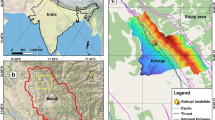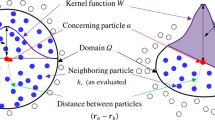Abstract
Siltation gradient and siltation length are important parameters for designing gravity check dams for debris flows, which directly affect the accuracy of estimates of interception capacity. At present, siltation gradient calculations are based primarily on empirical values, and range from 0.4 to 0.95 times the channel slope coefficient. The middle reaches of the Bailong River are one of the four areas in China that are most severely affected by debris flow hazards. Gravity dams are widely employed in this mountainous area. However, field studies of their capacity are lacking. In this paper, the operations of check dams were investigated. Based on field investigation results and theoretical analysis, calculations for siltation gradient, siltation length, and dam storage capacity are established. The impact of debris flow density, channel slope, and particle size weight percentages are discussed. The calculations show that the theoretical values for siltation gradient are consistent with measured values with 83.6% accuracy; and theoretical values of siltation length are consistent with measured values with 91.6% accuracy. The results of this research are an important reference for optimal height and spacing of dams, estimation of dam storage capacity, and disaster prevention.
Similar content being viewed by others
References
Amidon RE (1947) Discussion of “Model study of Brown Canyon debris barrier”. In: Bermel KJ, Sank RL (ed.) Transaction, ASCE (112): 1016.
Badri BS, Kawaika K, Yasuyuki B (2008) Numerical simulation on debris-flow deposition and erosion processes upstream of a check dam with experimental verification. Annuals of Disaster Prevention Research Institute, Kyoto University 51(B): 613–624.
Campisano A, Cutore P, Modica C (2014) Improving the evaluation of slit-check dam trapping efficiency by using a 1d unsteady flow numerical model. Journal of Hydraulic Engineering 140(7): 4010–4024. https://doi.org/10.1061/(ASCE) HY.1943-7900.0000868
Ferro V, Porto P (2011) Predicting the equilibrium bed slope in natural streams using a stochastic model for incipient sediment motion. Earth Surface Processes and Landforms 36(8):1007–1022. https://doi.org/10.1002/esp.2128
Flieshman CM (1986) Debris flow. Science Press, Beijing, China. (In Chinese)
He YQ, Wu Y, Li SL (2014) Research on the effect of one debris flow along Bailong river. Applied Mechanics and Materials 580-583: 701–704. https://doi.org/10.4028/www.scientific. net/AMM.580-583.701
José M, García R, Luis CA, et al. (2010) Upstream and downstream effects of check dams in braided rivers, central Pyrenees. In: Conesa García C, Aristide Lenzi M (ed.) Check dams, Morphological Adjustments and Erosion Control in Torrential Streams. pp 307–322.
Kang ZC (1996) Debris flow hazards and their control in China. Science Press, Beijing, China. (In Chinese)
Kim N, Nakagawa H, Kawaike K, et al. (2013) A study on debris flow deposition by the arrangement of sabo dam. Journal of Japan Society of Civil Engineers, Ser. B1 (Hydraulic Engineering) 69(4): 97–102.
Li F (2011) Experiment on relationship between slope of intercepted sediments behind gravity check-dam with the gradient of gully bed and the height of dam. Graduate University of Chinese Academy of Science, Chengdu, China. (In Chinese)
Lin XP (2013) Experimental study on discharge capacity of spillway of check dam. University of Chinese Academy of Science, Chengdu, China. (In Chinese)
Maricar F, Hashimoto H, Ikematsu S, et al. (2011) Effect of two successive check dams on debris flow deposition. Italian Journal of Engineering Geology and Environment 1073–1082. https://doi.org/10.4408/IJEGE.2011-03.B-116
Mizuyama T, Irasawa M, Amada T, et al. (1990) Analyses of sedimentation data on sabo dams. Sabo Gakkaishi 43(4): 33–35.https://doi.org/10.11475/sabo1973.43.4_33 (In Japanese)
Piton G, Guern J L, Carbonari C, et al. (2015) Sediment depositions upstream of open check dams: new elements from small scale models. EGU General Assembly Conference Abstracts. p 17.
Piton G, Recking A (2015) Design of sediment traps with open check dams. I: Hydraulic and Deposition Processes. Journal of Hydraulic Engineering 04015045(2): 1–16. https://doi.org/10.1061/(ASCE) HY.1943-7900.0001048
Shrestha BB, Nakagawa H, Kawaike K, et al. (2012) Driftwood deposition from debris flows at slit-check dams and fans. Natural Hazards 61(2): 577–602. https://doi.org/10.1007/s11069-011-9939-9
Shu HP, Sun S, Ma JZ, et al. (2016) Risk assessment of single debris flow gully in south Gansu province, China. Mountain Research 34(3): 337–345. https://doi.org/10.16089/j.cnki. 1008-2786.000137 (In Chinese)
Takahashi T, Nakagawa H, Satofuka Y, et al. (2002) Debris flow control by a grid-type sabo dam. Proc. Flood Defence, Science Press, New York.
Tang BX (2000) The debris flow in China. The Commercial Press, China. (In Chinese)
Tang C, Rengers N, Asch TWJV, et al. (2011) Triggering conditions and depositional characteristics of a disastrous debris flow event in Zhouqu city, Gansu Province, northwestern China. Natural Hazards and Earth System Sciences 11(11): 2903–2912. https://doi.org/10.5194/nhess-11-2903-2011.
Tian LQ, Wu JS, Kang ZC, et al. (1993) The erosion, transportation and deposition of debris flow. Chengdu Map Press, Chengdu, China. (In Chinese)
Tsuchiya Y (1969) Estimation of river bed aggregation due to dam. Proc. 13th, IAHR. 297–322.
Woolhiser DA, Lenz AT (1965) Channel gradients above gullycontrol structures. Journal of the Hydraulics Division 91(3): 165–187.
Wu JS, Tian LQ, Kang ZC, et al. (1993) Debris flow and its comprehensive control. Science Press, Beijing, China. (In Chinese)
Wu X, Ma DT, Yang M (2013) Experiment on siltation gradient of viscous debris flow behind gravity check-dam. Mountain Research 31(5): 594–600. (In Chinese)
Xiao HJ, Luo ZD, Niu QG, et al. (2013) The 2010 Zhouqu mudflow disaster: possible causes, human contributions, and lessons learned. Natural Hazards 67(2): 611–625. https://doi.org/10.1007/s11069-013-0592-3
Xiong MQ, Meng XM, Wang SY, et al. (2016) Effectiveness of debris flow mitigation strategies in mountainous regions. Progress in Physical Geography 40(6): 768–793. https://doi.org/10.1177/0309133316655304
Xu Q, Zhang S, Li WL, et al. (2012) The 13 August 2010 catastrophic debris flows after the 2008 Wenchuan earthquake, China. Natural Hazards and Earth System Sciences 12(1): 201–16. https://doi.org/10.5194/nhess-12-201-2012.
Yu B (2008) Research on the calculating density by the deposit of debris flows. Acta Sedimentologica Sinica 26(5): 789–796. https://doi.org/10.14027/j.cnki.cjxb.2008.05.024 (In Chinese)
Zhang P, Ma JZ, Shu HP, et al. (2014) Numercial simulation of erosion and deposition debris flow based on FLO-2D model. Journal of Lanzhou University (Natural Science) 50(3): 363–368. https://doi.org/10.13885/j.issn.0455-2059. 2014.03.011 (In Chinese)
Zhang Y, Meng X, Chen G, et al. (2016) Detection of geohazards in the Bailong River Basin using synthetic aperture radar interferometry. Landslides 13(5): 1–12. https://doi.org/10.1007/s10346-015-0660-8.
Zhou BF, Li DJ, Luo DF, et al. (1991) Guide to control for debris flow. Science Press, Beijing, China. (In Chinese)
Acknowledgement
This study was sponsored by the National Science and Technology Support Program (2014BAL05B01), STS Project of the Chinese Academy of Science (KFJ-EW-STS-094) and Scientific Project of Department of land and resources of Sichuan Province (KJ-2015-18). Furthermore, we would like to thank the anonymous reviewers and editors for their comments.
Author information
Authors and Affiliations
Corresponding author
Rights and permissions
About this article
Cite this article
Yuan, D., Liu, Jf., You, Y. et al. The siltation of debris flow behind check dam in the midstream of Bailong River. J. Mt. Sci. 15, 100–113 (2018). https://doi.org/10.1007/s11629-017-4484-y
Received:
Revised:
Accepted:
Published:
Issue Date:
DOI: https://doi.org/10.1007/s11629-017-4484-y




